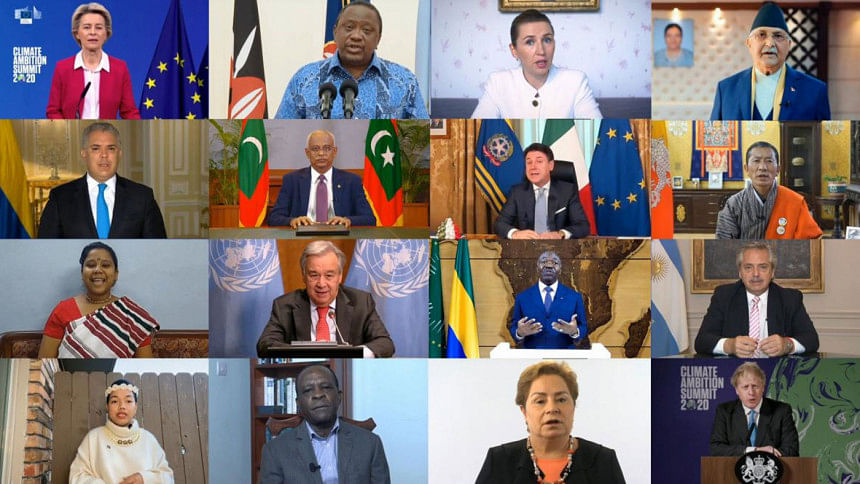Where is the $100 billion to tackle climate change?

On December 12, 2020, it was the fifth anniversary of the adoption of the Paris Agreement on Climate Change at the 21st Conference of Parties (COP21) of the United Nations Framework Convention on Climate Change (UNFCCC), and the occasion was marked by a Climate Ambition Summit hosted by Prime Minister Boris Johnson of the United Kingdom, who serves as the presidency of COP26 taking place in Glasgow, Scotland in November 2021.
The leaders who were invited to speak at the summit had to present their new pledges for reducing greenhouse gas emissions which the Paris Agreement required to be submitted in the form of revised Nationally Determined Contributions (NDCs) by all countries by December 31, 2020. Many global leaders did indeed present their enhanced ambition plans for reducing emissions by taking mitigation actions, and the global temperature that will result is now closer to 2 degrees Centigrade rather than 3 degrees, which was where we were previously headed. This is a move in the right direction but still not enough as we want the goal to be 1.5 degrees Centigrade.
Bangladesh Prime Minister Sheikh Hasina was invited to speak at the virtual summit representing both Bangladesh and the Climate Vulnerable Forum (CVF), which she now chairs, and she reiterated the actions that the vulnerable countries will be taking to reduce their own emissions of greenhouse gases even though we are but small emitters. Nevertheless, we are also taking actions and demanding that all countries make their NDC submissions by December 31.
However, while the emphasis of the summit and the pledges made were, quite rightly, on the need to enhance ambition to reduce emissions through mitigation, there is also another part of the Paris Agreement pledge which is supposed to be delivered by December 31—namely, the provision of raising USD 100 billion per year from 2020 onwards to help the developing countries tackle climate change through mitigation and adaptation. This particular pledge seems to be falling behind, and does not look like it will be reached by December 31.
In his speech, António Guterres, the secretary-general of the United Nations, called on all countries to declare a Climate Emergency, which Bangladesh has already done, and also called on the pledges for climate finance to support vulnerable developing countries to be delivered by the developed countries. The UN's own analysis has only been able to track less than USD 80 billion being promised by the end of 2020.
There is another issue, besides that of the USD 100 billion, which is of great importance for the vulnerable developing countries like Bangladesh: the proportion of the total amount being allocated to support adaptation in the most vulnerable developing countries and how that money is channeled. So far, the UN's analysis shows that only 20 percent of the global funds are going towards adaptation, while 80 percent are going towards mitigation activities in the bigger developing countries.
I would, therefore, like to pose some questions for the developed countries to address when they declare their pledges for their contribution towards that global goal of USD 100 billion going forward.
The first question is, how much of their own allocation is directed to adaptation and how much to mitigation? The demand from the developing countries is that the proportion should be 50/50.
The second question: how much of their contribution is being made as loans and how much as grants? The fact is, while mitigation actions can indeed generate a return by which loans can be repaid, that is not true for most adaptation projects. Hence, funding for adaptation through loans is not just morally wrong but also impractical. Unfortunately, a recent analysis by Oxfam has shown a large proportion of loans being counted by the developed countries in their climate finance support.
The third question is, through which channels are the developed countries making their climate finance contributions? From our perspective, we prefer the acknowledged climate change funds created under the UNFCCC, such as the Adaptation Fund (AF), the Least Developed Countries Fund (LDCF), the Green Climate Fund (GCF), or the Global Environment Facility (GEF). Channeling funds through the developed countries' own development assistance agencies, such as USAID in US, FCDO in UK and others, is problematic as it mixes Official Development Assistance (ODA) with climate finance and ends up double-counting each dollar, euro or pound given as both ODA and climate finance—which should not be the case.
The fourth and final question is, how much of their allocation on adaptation is going to the most vulnerable developing countries, and how much of that is reaching the most vulnerable communities in those countries to support locally led adaptation initiatives?
Unfortunately, the studies done so far found it very difficult to trace this number and has only been able to find that less than 20 percent of the adaptation funding actually reached the most vulnerable communities in the developing countries.
Hence the demand for greater transparency of how much is being allocated for adaptation, through which channels, to which developing countries, and indeed most importantly, how much is aimed at locally led adaptation.
Saleemul Huq is Director at the International Centre for Climate Change and Development (ICCCAD) at Independent University, Bangladesh.

 For all latest news, follow The Daily Star's Google News channel.
For all latest news, follow The Daily Star's Google News channel. 



Comments